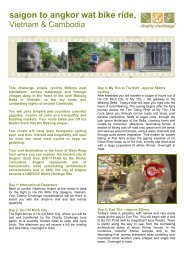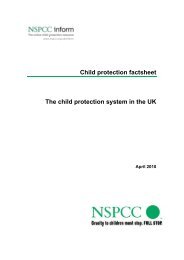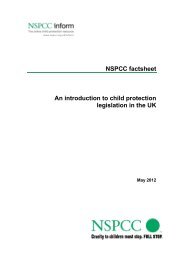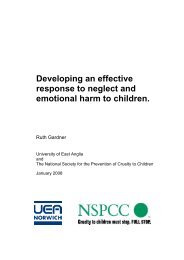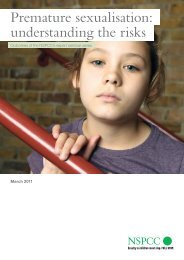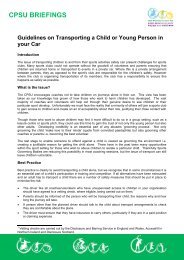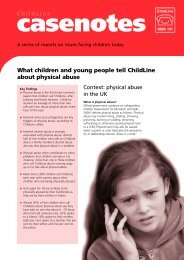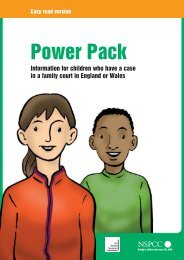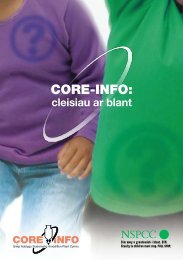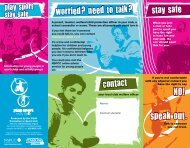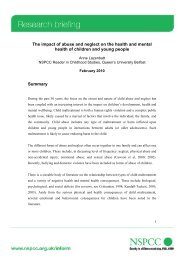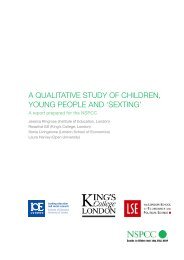Neglect and serious case reviews (PDF, 735KB) - nspcc
Neglect and serious case reviews (PDF, 735KB) - nspcc
Neglect and serious case reviews (PDF, 735KB) - nspcc
Create successful ePaper yourself
Turn your PDF publications into a flip-book with our unique Google optimized e-Paper software.
<strong>Neglect</strong> <strong>and</strong> Serious Case Reviews<br />
The circumstances of children who experience grave neglect which can result directly<br />
or indirectly in death or very <strong>serious</strong> harm, appear to be somewhat different at various<br />
age related stages. Considering the experience of neglect for children along a broadly<br />
developmental continuum can help to frame each child’s experience as an individual.<br />
This is particularly important in large families when the needs of the children in a<br />
family may tend to be considered more as a sibling group than individually. Similarly,<br />
although underst<strong>and</strong>ing broad developmental norms <strong>and</strong> expectations provides the best<br />
way to gauge the impact of neglect on the individual child, each <strong>case</strong> is unique <strong>and</strong> each<br />
child’s experience of neglect transcends their age <strong>and</strong> developmental stage. There is no<br />
substitute for knowing the child well.<br />
maiNtaiNiNg a healthy eNviroNmeNt<br />
Not all children experiencing severe neglect were receiving specialist help nor were their<br />
families making sure children took up available universal services. Where professionals<br />
were involved their interventions were not always effective. The evidence from this<br />
study suggests that one important way for these children to stay safe was to be more<br />
physically <strong>and</strong> emotionally healthy <strong>and</strong> for their living conditions to be safe <strong>and</strong> healthy.<br />
For this to happen there needs to be a safe living environment as a basic precondition for<br />
a safe relationship between children <strong>and</strong> their caregivers. This reinforces the need for<br />
decent living conditions for all children <strong>and</strong> families across the income spectrum. It also<br />
reiterates the importance of both early <strong>and</strong> late stage help, for children of all ages <strong>and</strong><br />
not just the youngest. However, <strong>serious</strong> <strong>case</strong> review findings underline the vulnerability<br />
of the youngest babies, especially in their first six months of life.<br />
messages for decision makers, policy makers, practitioners <strong>and</strong> managers<br />
• A public health approach offers good opportunities for prevention. This includes<br />
continued emphasis on the importance of basic health promotion messages about, for<br />
example, suicide prevention, accident prevention <strong>and</strong> the risks of sudden unexpected<br />
deaths in infancy (SUDI). SUDI risks include cigarette smoking <strong>and</strong> a potentially<br />
hazardous sleeping environment, like sofa sharing with an adult who has recently<br />
consumed alcohol or narcotics, or a baby not having their own cot or Moses basket<br />
(Blair et al 2009).<br />
80<br />
• Subst<strong>and</strong>ard accommodation combined with lapses in parental supervision can be<br />
life threatening <strong>and</strong> result in drowning, fire or accidental poisoning. Targeted support<br />
for families known to be vulnerable, including where children experience neglect,<br />
can help to prevent accidents (Reading et al 2008).<br />
• Vulnerable adolescents with a long history of neglect <strong>and</strong> rejection can rarely thrive<br />
living alone in isolated, poor quality accommodation <strong>and</strong> may dangerously neglect<br />
themselves. They need a safe, supportive environment <strong>and</strong> protected routes to<br />
adulthood <strong>and</strong> independence.



